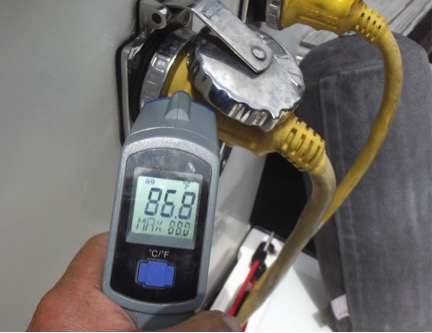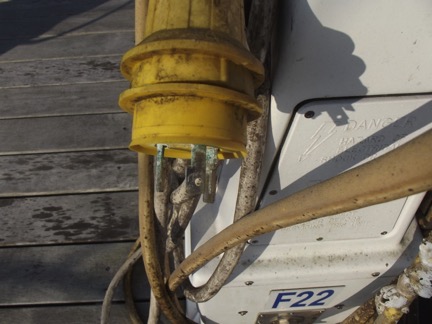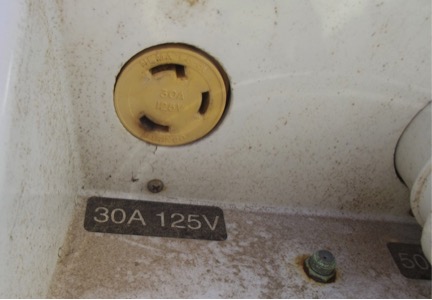Winter Cords
By Tom Hale
Living on the shores of Chesapeake we enjoy four pleasant seasons. The summers may be a bit hotter than we like and winters are at times colder than we like, but most years we can find a chance to be on the water every month of the year. Consequently, many boats stay in the water year round so we can take advantage of a surprise warm day in January or go for a sail in early March, knowing full well that we have not seen the last snow of winter.
A boat in the water in the winter can be a forlorn sight. She does not get regular visits as she does during the boating season, so it is important to be sure she is self-sufficient. Close all seacocks and keep the batteries charged. Check the bilge pumps regularly and keep the pumps operational. Winterize and shut off all the other systems. To ensure constant electrical supply to the battery charger, most boats are left plugged into shore power all winter. However, shore power cords have been the cause of a number of marina fires in winter. It is important that you inspect your cords and receptacles too.
Rather than fully winterize the boat, some choose to leave a light on in the engine compartment for heat. It used to be common practice to turn on a 100 watt light bulb to heat the engine space. This only draws an amp of power, but only produces 340 BTUs of heat. That is not much when the cold winter winds are blowing 25 and the temperature is in the single digits. This might be economical and might make you feel good, but it is not an effective and reliable means to keep the boat from freezing. Marine engine room heaters specifically designed for this application are needed. These heaters will draw 5-10 amps each, and you will probably employ two or more. It is the constant current draw of heaters that puts a strain on the electrical system.
If you come to visit the boat in winter, you will probably bring a small electric cabin heater. A 1500 watt heater draws 12.5 amps and produces 5,000 BTUs of heat. On a cold day in winter that heater barely seems to warm the boat. So, when you do visit the boat in winter, and there is something very enjoyable about being aboard with gently falling snow, you are likely to employ more than one heater to take the chill off the cabin. Running two heaters will draw 25 amps. If you have a 30 amp service, turning on a couple of lights and you are now drawing over 85% of the full load through the shore cord and the onboard power system. Live aboards know what happens next, one more device comes on, the current exceeds 30 amps, and the breaker pops.
Load it up
Drawing 85% of the rated current load for an extended period will “load test” the power cord receptacles both on the boat and on the dock. If there is resistance anywhere in the system, commonly seen at the power cord plug ends, a heavy continual load will generate heat. Before you leave the boat for the winter, it is the time to check for heat at these critical junctions at the cord ends. Turn on as many loads as you can but stay under the circuit breaker trip rating. Wait 20 minutes and then check the dock receptacle and hull inlet. A simple, if imprecise, means to test the temperature is to put your hand to the cord plug at the receptacle. The cord end should feel the same temperature as your hull or the dock power post. If it feels warm to the touch there is resistance in the connections causing heat. If you can feel heat it is a warning that the connection has corrosion.
A far more accurate and reliable test is to measure the actual temperature of the electrical connection with an infra-red pyrometer. Use the tool to measure the surface next to the power cord plug and establish the ambient temperature then focus on the cord to see what the plug temperature is. Turn on heaters and other loads to generate a continual load of 25 to 30 amps. It is normal to see a couple of degree temperature rise. 5 degrees is OK, but if the temperature of the cord end is 10 degrees above ambient, trouble is brewing. Keep the boat loads on and check the cord every 10 minutes until you are sure the temperature at the connection has stabilized. If the temperature stabilizes at 20 degrees above ambient, or more, then you need to investigate and repair the electrical connection. Either the receptacle, the plug, or both is corroded adding resistance to the circuit.
There is a pattern to winter marina fires. The fires often break out at night. As the overnight temperatures dip, boat heaters will stay powered up and drawing current for a longer period in each cycle. It may get cold enough that your heaters are running continuously. And you are not alone. All the heaters aboard all the boats are running longer as the temperature drops. This increases the overall marina dock current (amperage) load. As the dock voltage drops, each heater will have to draw more current . A 1,500-watt heater draws 12.5 amps at full 120-volt dock power. The current draw (amperage) climbs to 14.3 amps if the dock voltage drops to 105V. Even though you have changed nothing aboard your boat, the combined load heaters will increase from 25 amps to 28.6 amps. This current draw is below the breaker trip value, but the hull inlet and dock receptacle are now being run at just about max load. If any cord set, any hull inlet or any dock receptacle has a high resistance connection such as corrosion in the wire terminations or the plug surfaces, it is going to heat up and eventually one of the connections will catch fire.
Every winter there will be one or more marina fires; overheated power cords are a common cause. Don’t let your boat become a statistic. If you live aboard, check the power cord any time it is heavily loaded. If you are not aboard, winterize all systems and do not rely solely on heaters to protect the boat from freezing. Any time you are walking to and from the boat carry your infra-red pyrometer with you and take a moment to check the temperature of the cords of other boats on the dock. If you find any heated cord, notify the marina, the boat you save may be your own.
Winterize power cords
- During your winterization procedures, disconnect the shore power cable at both ends and be sure all the connections are clean and dry.
- Clean the blades. Replace any corroded or burned fittings. It is particularly important to check the power post receptacle for damage. This piece of hardware is the responsibility of the marina.
- Put silicone grease on the electrical blades.
- Reconnect the power cable and tighten the locking rings. If the shore power receptacle is not weather tight then you MUST, using shrink wrap plastic and tape, protect the receptacle so wind driven rain and snow cannot get in.
- Always use the locking rings on your cords!
- Monthly – Turn on a heavy load such as multiple heaters and check the temperature at your hull inlet and at the power post.





